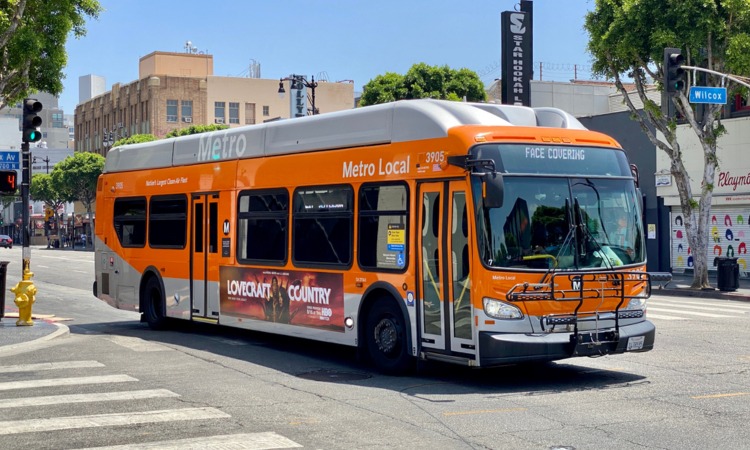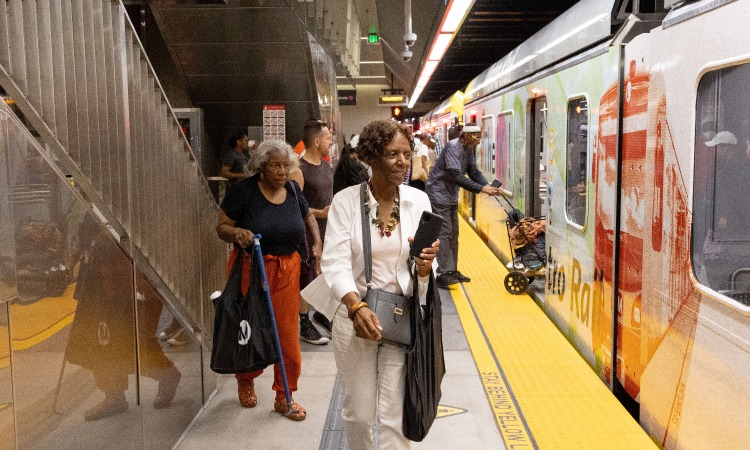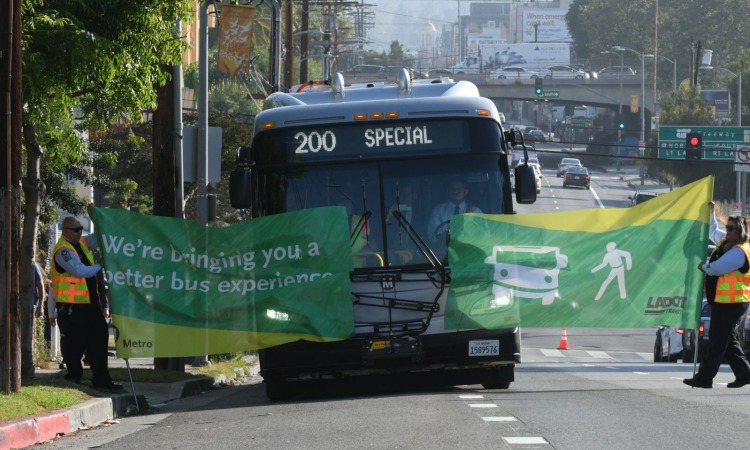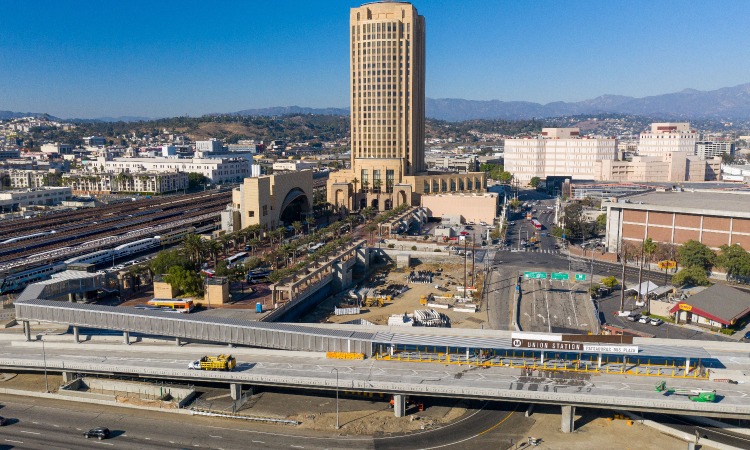Getting passengers back on-board: LA Metro’s road to recovery
- Like
- Digg
- Del
- Tumblr
- VKontakte
- Buffer
- Love This
- Odnoklassniki
- Meneame
- Blogger
- Amazon
- Yahoo Mail
- Gmail
- AOL
- Newsvine
- HackerNews
- Evernote
- MySpace
- Mail.ru
- Viadeo
- Line
- Comments
- Yummly
- SMS
- Viber
- Telegram
- Subscribe
- Skype
- Facebook Messenger
- Kakao
- LiveJournal
- Yammer
- Edgar
- Fintel
- Mix
- Instapaper
- Copy Link
Posted: 14 December 2022 | Stephanie Wiggins - LA Metro | 1 comment
For the latest instalment of Intelligent Transport’s exclusive COVID-19 recovery series, Stephanie Wiggins, CEO of LA Metro, provides insight into the new services that the authority has introduced in order to meet the changing mobility requirements of its customers post-pandemic, as well as why it is important to focus on the needs of women and families when developing transport services to drive an equitable post-pandemic recovery.


Credit: LA Metro
In March of 2020, with COVID-19 spreading fast and stay-at-home orders in place, everything changed in Los Angeles (LA) County. Roads that had been congested for the better part of the past century emptied. Our local skies cleared, freed from smog. More than half of LA Metro’s riders were suddenly gone – and stayed gone for the next year, leaving some to wonder what, if any, future awaited transit in our region.
We are well on our way to recovery from the pandemic. In October 2022, our ridership reached 72.5 per cent of pre-pandemic levels – the highest we have seen since the pandemic began”
Now, I’m pleased to report that we are well on our way to recovery from the pandemic. In October 2022, our ridership reached 72.5 per cent of pre-pandemic levels – the highest we have seen since the pandemic began, and we’re making good progress toward our ambitious goal recovering our pre-pandemic ridership by 1 July 2023. At LA Metro, we’re recovering our ridership because we’re listening to the needs of our customers, we’re making service improvements through a gender and equity lens and we’re putting people first.


Credit: LA Metro – Riders hopping on-board the K Line train that opened to the public in October 2022.
Putting people first
For LA Metro, putting people first is more than just a catchy mantra; it’s an organising principle that applies to our riders and the employees who deliver our service. Putting people first means making our service friendlier, cleaner, faster, more dependable, more family oriented and more reflective of how people travel today – and it’s working.
During the pandemic, we took the opportunity to implement our new NextGen bus plan, to maximise our customers’ access to jobs and destinations of interest. Today with NextGen, 1.1 million more jobs are now accessible through very frequent, 10-minute or better, bus service. This represents a 350 per cent improvement over our pre-pandemic service structure. NextGen also increased our customers’ access to key destinations, likes grocery stores, educational institutions, parks and medical centres, and it focused the improvements in communities that need to use transit most.
If we orient our service around the needs of women and families, we’ll be more successful in growing ridership”
NextGen doesn’t just align our service to where people are travelling today – it also aligns our service with who is traveling today. Before NextGen, our bus system didn’t really consider how women, who are half of the bus riding population, use our system differently from men. It’s my belief that if we orient our service around the needs of women and families, we’ll be more successful in growing ridership. We know from previous studies that women make more frequent trips, go to different destinations, and tend to travel more during the off-peak period than men, so, to meet their needs, we increased our frequent midday service and created more opportunities for shorter, faster transit trips.
We also enhanced customer service and safety through adding Metro Ambassadors to the system, a key priority for our female riders. More than 150 Metro Ambassadors have been deployed so far on our system, to support our riders, connect those who need it to resources and report issues on the system to make sure we can address them quickly. This is a key part of our newly re-imagined, layered and people-centric approach to public safety.


Credit: LA Metro – With travel down during the pandemic, LA Metro added new peak-hour bus lanes in the city of Los Angeles, including this one on Alvarado Street.
Improving affordability
Since September 2021, we’ve doubled enrolment in our low-income discount programme and delivered more than 9.5 million discounted rides”
We’ve been working hard to make our fares affordable and easy to pay. We temporarily reduced the price of passes and will eliminate them entirely when we launch fare capping in 2023 – and we expanded and discounted our low-income fares and reduced the paperwork needed to sign up. That’s important because our data shows that 75 per cent of our riders are from low-income households. Since September 2021, we’ve doubled enrolment in our low-income discount programme and delivered more than 9.5 million discounted rides.
We have also developed programmes that cultivated new riders. Our GoPass pilot programme provides access to free transit to more than one million K-12 and community college students in LA County. So far in 2022, we’ve delivered more than 10.2 million free rides to GoPass holders, and the share of student ridership has almost tripled compared to pre-pandemic levels. We’re putting money back in the pockets of families, contributing to academic excellence and showing our next generation of riders that it’s easy to get around on transit.
Building for the future
Angelenos spend a lot of time in traffic. Making mass transit a viable option… is still the best tool we have in our toolbox right now to address this problem”
While improvements like NextGen, GoPass and LA Metro Ambassadors are important and necessary, it’s incumbent upon us to never lose sight of the bigger picture. There are 10 million people in Los Angeles County – and millions more who commute into the region from other southern California counties.
Angelenos spend a lot of time in traffic. Making mass transit a viable option – moving people out of cars and into buses and trains – is still the best tool we have in our toolbox right now to address this problem. This is why it’s critical that we keep making progress.
The first phase of our K Line light rail project opened in October 2022 with seven new stations – and the second phase will finally connect our rail system to Los Angeles International Airport when it opens in 2024. Bus lanes are being added throughout the City of Los Angeles.
A tunnel that will connect three of our light rail lines will open in 2023 and make travel to and through downtown LA speedier with fewer transfers. Work is underway on our subway extension to LA’s traffic-plagued Westside – with the first four-mile section to open in 2024. A light rail extension in the San Gabriel Valley is half complete and is scheduled to open in 2025, providing another key link to the regional rail.


Credit: LA Metro – New bus platform at Los Angeles Union Station is one of the many projects to open during the pandemic.
We’re improving mobility for the nearly two million people who live in the San Fernando Valley part of our region. We just broke ground for the initial utility work on the East San Fernando Valley light rail line, and we’ll soon break ground on two other bus rapid transit (BRT) improvements.
All those projects and more are slated to be completed before the 2028 Olympic and Paralympic Games. The last time Los Angeles hosted the Olympic Games, we didn’t even have a rail system. In 2028, our region is going to have more than 135 miles of Metro rail, 538 miles of Metrolink regional rail, dozens more miles of full BRT, many more miles of light BRT, and dozens of miles of new bike and active transportation infrastructure.
What are we going to do to make the most of this opportunity?
By uplifting our employees and focusing on the needs of women and families, we are well on our way to an equitable pandemic ridership recovery”
Well – we have a plan for that too: our Mobility Concept Plan includes projects that will ensure that our system is ready for the millions of people who will use our buses, trains and more during the games, and the millions more who will continue to use it after the games are over.
The plan includes making improvements at key stations, providing dedicated bus lanes, expanding our micro-transit pilot and creating integrated ticketing for events. We’re seeking funding for this plan from the state and federal governments.
When you step back and look at everything that we’re already doing, we’re on a path to transform this region.
We’re cautiously optimistic. The return of traffic – long the scourge of LA – validates our view that our region and its economic survival depend on us operating and building a world-class transit system to serve Greater Los Angeles area for decades to come. By uplifting our employees and focusing on the needs of women and families, we are well on our way to an equitable pandemic ridership recovery.


Related topics
Accessibility, COVID-19, Getting Passengers Back On-Board: Transport's Road to Recovery Series, Mobility Services, Passenger Experience, Public Transport, Ticketing & Payments
Related modes
Bus & Coach, Light Rail, Rail
Related cities
Los Angeles
Related countries
United States
Related organisations
LA Metro
Related people
Stephanie Wiggins









LA Metro has the right focus. Thank you CEO Wiggins.